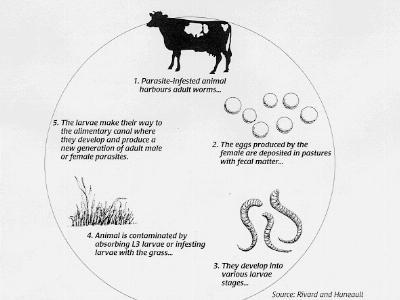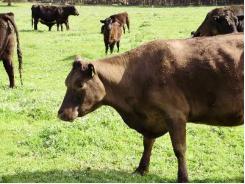Diseases of Cattle: Internal parasites

The economic losses from worm parasite infections of cattle can be significant. Calves under one year of age are more susceptible than older cattle who frequently have been exposed to the parasites and have developed a degree of immunity.
Adult worms in cattle produce eggs that are passed in the manure. The eggs hatch, producing larvae that develop and move up onto the pasture grasses where cattle consume them. Eggs can survive the winter and hatch out with warm weather. Infection is most likely to occur when temperatures are between 60° and 80°F. and there is adequate rainfall. Deworming prior to the grazing season will greatly reduce the contamination of pastures during the grazing season. Cows dewormed in the fall usually have a higher conception rate the next breeding season, winter better and wean heavier calves.
There are several several anthelmintics approved for use in beef cattle. It is probably a good idea to rotate the wormer you use. Consult your veterinarian concerning the type to use and the timing to be the most cost effective for your area. Several are listed below by active ingredient and (brand).
Albendazole (Valbazen) is available in paste or suspension. It is effective against all intestinal worms including tapeworms, and lungworms as well as liver flukes. It has a 27-day withdrawal for slaughter. It should not be used in animals during the first 45 days of pregnancy.
Fenbendazole (Panacur, Safeguard) is available as a stable suspension or granules. It is effective against roundworms in the gut, larval forms in the tissues, and lungworms. Withdrawal time to slaughter is 8 days.
Ivermectin (Ivomec) for cattle is an effective medication against the internal worm parasites including lungworms as well as cattle grubs and sucking lice. It is available in injectable or pour-on formulations. Withdrawal time to slaughter is 35 days.
Levamisole (Levisol, Tramisol) is available in boluses, a paste for oral administration, as a pour-on or an injectable form. Levamisole is effective against roundworms and lungworms. Withdrawal time is orally 2 days and injected 7 days.
Morantel tartrate (Rumatel) comes in boluses or crumbles for oral use. It is effective against roundworms, and has a 14-day withdrawal time to slaughter.
Oxfendazole (Synonthic) is a new wormer that is effective against intestinal parasites including tapeworms. This wormer has a unique delivery system in that the wormer is injected directly into the rumen. Oxfendazole is also available in the drench form. It has a 7 day withdrawal time to slaughter.
Thiabendazole (Omnizole, TBZ) for oral administration is available in paste, boluses, suspension, or crumbles. It is effective against roundworms. Withdrawal time to slaughter is 3 days.
Có thể bạn quan tâm
Phần mềm

Phối trộn thức ăn chăn nuôi

Pha dung dịch thủy canh

Định mức cho tôm ăn

Phối trộn phân bón NPK

Xác định tỷ lệ tôm sống

Chuyển đổi đơn vị phân bón

Xác định công suất sục khí

Chuyển đổi đơn vị tôm

Tính diện tích nhà kính

Tính thể tích ao hồ




 Diseases of Cattle: Johne's Disease
Diseases of Cattle: Johne's Disease  Diseases of Cattle: External parasites
Diseases of Cattle: External parasites